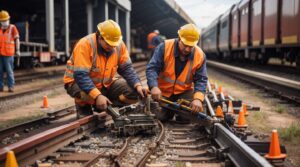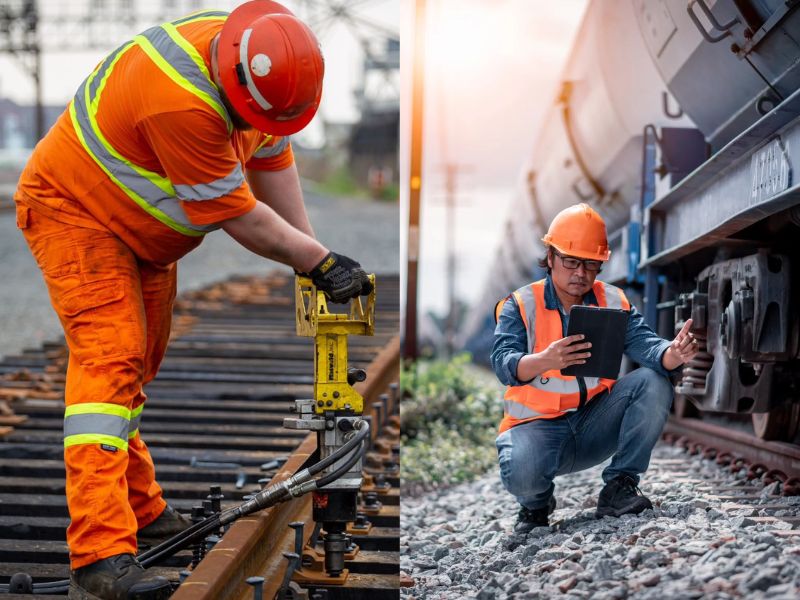Railway track maintenance is a critical aspect of ensuring the safety and efficiency of rail transport systems. As trains traverse vast distances at high speeds, the integrity of the railway track becomes paramount.
Regular maintenance not only prevents accidents but also enhances the overall performance and longevity of railway infrastructure.
In this article, we will explore why consistent track maintenance is essential for railway safety and how it contributes to a reliable transportation network.
Railway Track Maintenance: What is it?
Railway track maintenance refers to the systematic upkeep and repair of railway infrastructure. This process is crucial for ensuring that tracks remain safe and functional for trains. Regular maintenance helps prevent accidents, reduces wear and tear, and enhances the overall efficiency of rail transport systems.
Key Components of Railway Track Maintenance
Understanding the key components involved in railway track maintenance is crucial for ensuring safety and efficiency. Each element plays a specific role in supporting the overall integrity of the railway system. So here are some of the main components of railway track maintenance:
1. Rails
Rails are the primary components that guide trains along the track. They must be regularly inspected for wear, cracks, and other damage. Proper rail maintenance includes grinding and replacing sections as needed to ensure a smooth ride and prevent derailments.
2. Sleepers
Sleepers, also known as ties, support the rails and maintain their alignment. They absorb the weight of passing trains and distribute it evenly to the ballast below. Regular inspection of sleepers is necessary to identify rot or damage, which can compromise track stability.
3. Fasteners
Fasteners secure the rails to the sleepers, preventing any movement during train operations. These components include clips, bolts, and plates that must be regularly checked for tightness and wear. In addition, replacing worn fasteners is essential to maintaining track integrity.
4. Ballast
Ballast consists of crushed stone or gravel that supports the track structure. It provides stability by distributing the weight of trains and facilitating proper drainage. Regular maintenance of ballast involves cleaning and redistributing it to ensure effective drainage and prevent track shifting.
Importance of Each Component
Each component plays a vital role in maintaining track safety and performance. Rails ensure smooth train movement; sleepers provide support; fasteners secure everything in place; and ballast stabilizes the entire structure. Therefore, regular maintenance of these elements is essential for optimal railway operations and safety.
Importance of Regular Maintenance
Regular maintenance is vital for the safety and efficiency of railway systems. It plays a crucial role in preventing accidents, extending the lifespan of infrastructure, and providing economic benefits. By focusing on these key areas, railway operators can ensure a reliable transportation network.
Preventing Accidents and Ensuring Safety
One of the primary goals of regular railway track maintenance is to prevent accidents. Regular inspections help identify potential issues, such as worn rails or loose fasteners, before they lead to serious incidents.
In addition, maintaining proper track alignment reduces the risk of derailments. Trains operate at high speeds, making it essential to keep tracks in optimal condition. By addressing maintenance needs promptly, operators can significantly enhance safety for passengers and freight.
Extending the Lifespan of Railway Infrastructure
Regular maintenance extends the lifespan of railway infrastructure. Tracks endure constant stress from heavy trains, which can lead to wear and damage over time.
By implementing routine maintenance practices, such as rail grinding and sleeper replacement, operators can minimize deterioration. This proactive approach reduces the frequency of major repairs and replacements, saving time and resources in the long run.
Furthermore, well-maintained tracks contribute to smoother train operations. This not only enhances passenger comfort but also decreases wear on trains themselves, prolonging their operational life.
Economic Benefits of Regular Maintenance
Investing in regular maintenance yields significant economic benefits for railway operators. While maintenance requires upfront costs, it ultimately reduces long-term expenses associated with major repairs and infrastructure replacements.
In addition, efficient maintenance practices lead to improved operational efficiency. Trains can run on schedule with fewer disruptions caused by track issues. This reliability enhances customer satisfaction and can attract more passengers or freight business.
Moreover, regular maintenance helps avoid costly accidents that can result in legal liabilities and damage to reputation. By prioritizing safety through consistent upkeep, operators protect their investments and ensure sustainable operations.
So, it can be said that effective railway maintenance relies on advanced inspection and testing techniques. Our ultrasonic examination ensures internal rail integrity, while Level III services provide expert oversight for non-destructive testing programs. Reach out today and keep your tracks safe and operational with industry-leading maintenance solutions.
Types of Track Maintenance

There are four main types of railway track maintenance: routine, preventive, corrective, and emergency maintenance. Each type serves a specific purpose in ensuring the safety and reliability of the railway system.
1. Routine Maintenance
Routine maintenance involves regular visual inspections and general upkeep of the track. Inspectors check for visible signs of wear, misalignment, or damage.
In addition, routine maintenance includes replacing worn-out parts to maintain track integrity. Timely replacements prevent minor issues from escalating into major problems.
2. Preventive Maintenance
Preventive maintenance focuses on anticipating potential issues before they arise. This approach involves conducting regular inspections to identify early signs of wear.
Minor repairs are performed during these inspections to address issues promptly. This proactive strategy helps maintain optimal track conditions and reduces the likelihood of accidents.
3. Corrective Maintenance
Corrective maintenance addresses identified issues that require immediate attention. When inspectors find problems, such as broken rails or drainage issues, they take action quickly.
Examples include repairing broken rails to prevent derailments and fixing drainage problems to avoid water accumulation. This type of maintenance is essential for ensuring track safety and performance.
4. Emergency Maintenance
Emergency maintenance responds to urgent repair needs that arise unexpectedly. This type of maintenance is crucial during situations like natural disasters or accidents.
For instance, after a severe storm, crews may need to repair washed-out tracks quickly. Swift action ensures that train services can resume safely and efficiently.
Key Maintenance Activities
Key maintenance activities are essential for ensuring the safety and efficiency of railway tracks. These activities include rail grinding, tamping, ballast management, and component replacement.
1. Rail Grinding
Rail grinding improves the surface of the rails by removing irregularities. This process enhances train performance and reduces noise levels during operation.
In addition, rail grinding helps extend the lifespan of the rails. Operators typically perform this activity every few years, depending on usage and wear.
Various techniques are used for rail grinding, including mobile grinders and specialized machinery. These methods ensure precise results and maintain track safety.
2. Tamping
Tamping is crucial for maintaining track alignment and stability. This process involves packing ballast under the sleepers to ensure proper support.
Proper tamping prevents track misalignment caused by train vibrations. Therefore, it plays a significant role in enhancing overall safety and performance.
3. Ballast Management
Ballast plays a vital role in track stability and drainage. It supports the weight of trains while allowing water to flow away from the track.
Regular ballast management involves cleaning and redistributing ballast to maintain its effectiveness. Techniques include using specialized machinery to lift and reposition ballast as needed.
4. Replacement of Components
Replacing rails and sleepers is necessary when they become worn or damaged. Operators must assess the condition of these components regularly to determine when replacements are needed.
Timely replacement enhances overall track safety and prevents accidents. Therefore, maintaining a proactive replacement schedule is essential for reliable railway operations.
Challenges in Track Maintenance
Track maintenance faces several common challenges that can impact safety and efficiency. Identifying these issues is essential for effective management.
Common Issues Faced in Maintenance Operations
Some common challenges faced in maintenance are as follows:
- One major challenge is the aging infrastructure that requires constant attention. Many railway systems struggle with outdated equipment and materials.
- Weather conditions also pose significant challenges. Extreme temperatures, heavy rainfall, and snow can damage tracks and delay maintenance efforts.
- Limited budgets often restrict maintenance activities. Insufficient funding can lead to deferred maintenance, increasing the risk of accidents.
Strategies to Overcome These Challenges
To address aging infrastructure, operators should prioritize the following:
- Investing in new technologies can enhance maintenance efficiency and effectiveness.
- Implementing a robust maintenance schedule helps mitigate weather-related issues. Regular inspections and timely repairs can prevent weather damage from escalating.
- Securing additional funding through government grants or partnerships can improve budget constraints. Collaborating with stakeholders can lead to more sustainable maintenance practices.
Final Thoughts
Regular railway track maintenance is essential for ensuring the safety, efficiency, and longevity of rail transport systems. By understanding the importance of maintenance and the various types involved, operators can proactively address potential issues before they escalate.
Key activities such as rail grinding, tamping, ballast management, and component replacement play a significant role in maintaining track integrity.
Despite facing challenges like aging infrastructure and budget constraints, implementing effective strategies can help overcome these obstacles. Prioritizing maintenance not only prevents accidents but also enhances operational efficiency and reduces long-term costs.
Ultimately, a commitment to regular track maintenance fosters a safer and more reliable railway network for passengers and freight alike. By investing in the future of railway infrastructure, operators can ensure that rail transport remains a vital component of our transportation system.
Key Points
- Railway Track Maintenance involves systematic upkeep and repair of railway infrastructure to ensure safety and functionality.
- Regular maintenance prevents accidents, extends the lifespan of railway infrastructure, and provides significant economic benefits.Maintenance can be categorized into routine, preventive, corrective, and emergency types, each serving a specific purpose.
- Routine Maintenance: This includes regular visual inspections and general upkeep to identify and address minor issues before they escalate.
- Preventive Maintenance: Focuses on anticipating potential problems through regular inspections and minor repairs to maintain optimal track conditions.
- Corrective Maintenance: Addresses identified issues that require immediate attention, such as repairing broken rails or fixing drainage problems.
- Emergency Maintenance: Responds to urgent repair needs due to unexpected events like natural disasters or accidents.
- Important activities include rail grinding, tamping, ballast management, and replacement of components to ensure track safety.
- Common issues include aging infrastructure, adverse weather conditions, and budget constraints that can hinder maintenance efforts.
- Effective strategies include modernizing infrastructure, implementing robust maintenance schedules, and securing additional funding through partnerships or grants.
FAQs
Why is regular railway track maintenance necessary?
Regular railway track maintenance is essential to prevent accidents, ensure safety, and extend the lifespan of railway infrastructure.
How does preventive maintenance work?
Preventive maintenance anticipates potential issues through regular inspections and minor repairs to avoid major problems.
What is corrective maintenance?
Corrective maintenance addresses identified issues that require immediate attention, such as repairing broken rails or fixing drainage problems.
How does ballast management contribute to track safety?
Ballast management ensures proper drainage and stability of the track, preventing issues related to water accumulation and erosion.
What role does rail grinding play in track maintenance?
Rail grinding improves rail surfaces by removing irregularities, enhancing train performance and extending rail lifespan.

